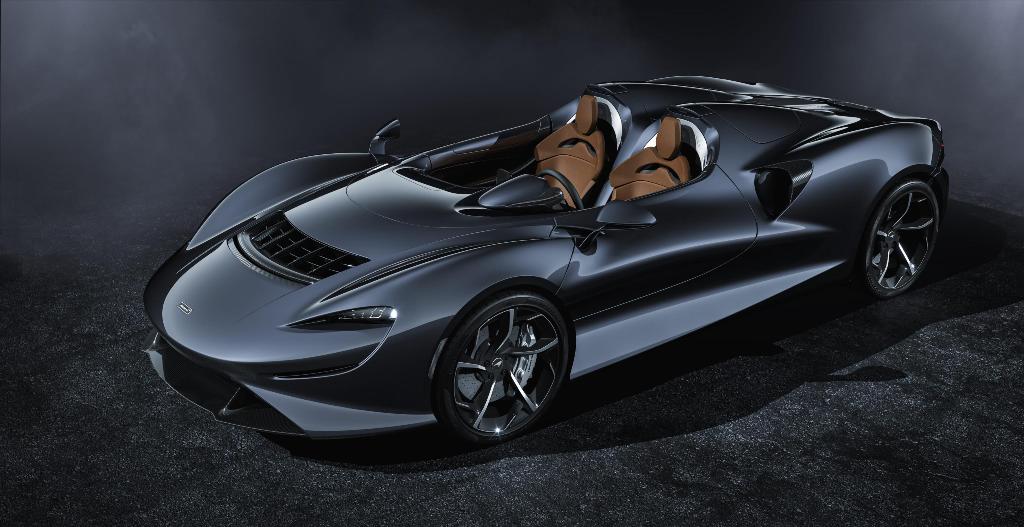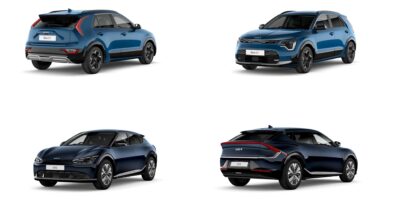McLaren Automotive reveals its new Ultimate Series roadster, the McLaren Elva. As the brand’s first open-cockpit road car, the Elva adds a new dimension to the range-topping Ultimate Series lineage. Like its McLaren P1TM, McLaren Senna and Speedtail predecessors, volume of the new McLaren Elva will be strictly limited: just 399 are being offered for customer order.
The Elva name celebrates the renowned Bruce McLaren-designed M1A and McLaren-Elva M1A [Mk I], M1B [Mk II] and M1C [Mk III] of the 1960s. Produced as ‘customer’ versions of the innovative and exciting Group 7 McLaren race cars, the McLaren-Elva sportscars embodied many of the pioneering design and engineering principles that are integral to the McLaren road cars produced today.
“McLaren continues to push the boundaries of supercar and hypercar development in pursuit of outstanding and unparalleled driving experiences for our customers and the McLaren Elva epitomises that pioneering spirit. The McLaren-Elva M1A [Mk1] and its successors are in many ways the true spiritual forerunners of today’s McLarens – superlight, mid-engined cars with the highest levels of performance and dynamic excellence. It’s fitting that the new McLaren Ultimate Series roadster – a uniquely modern car that delivers the ultimate connection between driver, car and the elements and with that new heights of driving pleasure on road or track – acknowledges our rich heritage with the Elva name.â€
Mike Flewitt, CEO, McLaren Automotive
The new McLaren Elva is a ferociously fast open-cockpit car; an extreme two-seater with a bespoke carbon fibre chassis and body but no roof, no windscreen and no side windows. With every sensory input heightened, this is a car that exists to provide unparalleled driving pleasure on road or track.
A 4.0-litre, twin-turbocharged McLaren V8 from the same family of engines that powers the McLaren Senna and Senna GTR combines with the lightest vehicle weight1Â of any road car produced by McLaren Automotive to give the superlight new Ultimate Series roadster truly breathtaking performance across the board, with extraordinary levels of acceleration, agility and driver feedback.
The appearance of the McLaren Elva is as striking and unique as the driving experience. The low nose and pronounced front fender peaks provide visual drama and at the same time enhance forward vision. Large, carbon fibre rear fenders flow from the front of the door to the rear deck, while the height of the twin rear buttresses is minimised by using a deployable roll-over protection system.
Helmets can be worn if preferred, but the form and sculpture of the upper cabin wraps around the driver and passenger to provide a secure environment. A fixed windscreen derivative of the car is also available for most markets as a factory option.
Aesthetic and technical design in harmony
McLaren’s design philosophy intrinsically links aesthetic design and technical design, rather than separating the disciplines of design and engineering as is commonplace in the automotive industry. The AAMS is an example of the results of this harmonious approach, being perfectly integrated within the aerodynamic and cooling functionality of the McLaren Elva.
When the AAMS is inactive, the central duct is sealed, diverting air flow into the low-temperature radiators and increasing their cooling efficiency. To provide optimal packaging conditions for the AAMS, the McLaren Elva features twin low-temperature radiators (LTRs) positioned ahead of each front wheel. The new cores used in these LTRs contribute to the engine’s 815PS power output by reducing charge air temperature and also cool the oil in the seven-speed seamless shift transmission.
In addition to housing the AAMS, the front clamshell features deep contours that guide air into a discreet duct in the leading edge of each carbon fibre door – notably the lightest that McLaren has ever created. This captured cooling air is then directed into the two rear-mounted, powertrain-cooling, high-temperature radiators (HTRs) located just ahead of the rear wheels. A second, lower duct that starts inside the front wheelarch also channels air through the bodyside to the HTRs, which are additionally fed through the visible main side intakes. Intakes on the rear of each buttress channel combustion air into exposed air filters under the tonneau, which feed the carbon fibre engine plenum.
The trailing edge of the bodywork features a full-width active rear spoiler, the height and angle of which are adjusted simultaneously to optimise aero balance. Airbrake functionality improves braking from high speeds, the range of operation varying according to whether the AAMS is active. The rear diffuser works in conjunction with the active rear spoiler. The McLaren Elva has a completely flat underfloor until the point by the rear axle at which the diffuser starts and increases in height to accelerate air out from under the vehicle. The diffuser features vertical ‘fences’ to guide the airflow without reducing the air evacuation path and these combine with the rear bumper side extensions to further improve the aerodynamic efficiency.
Designed to deliver an elemental driving experience
“Our mission with the McLaren Elva was to create an open-cockpit, two-seat roadster that delivers the most elemental of driving experiences. Formula 1-inspired shrink-wrapped volumes create a technical sculpture that is as striking as it is remarkable, the exterior flowing into the interior in a stunning example of a new and unique McLaren ‘blurred boundaries’ design principle that has allowed us to seamlessly bring the outside in, to further enhance driver engagement while remaining true to our philosophy of making no compromises.â€
Rob Melville, Design Director, McLaren Automotive
Highlighting the intensity of the driving experience through the direct connection to the elements, there is no clear demarcation between the exterior of the McLaren Elva and the interior. The uppermost sections of the carbon fibre doors simply curve over and flow down into the cabin, the light, stiff and strong composite material providing the perfect properties to form such enticing shapes and forms. Complementing this unique design feature, the buttresses behind the driver and passenger also flow into the cabin behind the seats. While ensuring the driver and passenger remain exposed to the elements, the sculpture of the wraparound upper cabin environment enhances the feeling of security and protection within a cocooned interior.
A spar of carbon fibre additionally sweeps down from between the buttresses and runs between the driver and passenger seats to support a central armrest and cradle the engine start button and the controls for Drive, Neutral and Reverse functions. The seats themselves are of a bespoke design, with a new lightweight carbon fibre shell that not only supports the head, shoulder and back area of the occupants, but works seamlessly with the upper shape of the cabin. The lower area of each seat is marginally shorter than a conventional McLaren seat, allowing enough space within the footwells for driver or passenger to stand should they want to in order to enter or leave the vehicle. The seats are available with different upper and lower colours and materials, creating a contrast between the exposed upper section and cocooned lower section. Six-point race harnesses can be selected should the customer wish to use the McLaren Elva on track.
Ahead of the driver and passenger, the view forward is unprecedented, with the dashboard seamlessly flowing down into the cabin and around to meet the swooping doors. The shapes are organic and natural – almost pebble-like – with the only interruption to their smooth forms the instrument cluster that stands proud, moving with the steering wheel to optimise visibility of vehicle data for the driver.
In a first for McLaren, the controls for the Active Dynamics functions are integrated into the instrument cluster; set either side of the binnacle, the dynamic mode switches are situated close to the gearshift paddles and their operation does not require the driver to remove their hands from the steering wheel. Additional functionality is accessed through the centrally-mounted 8-inch high-resolution touchscreen monitor; a hub for all the vehicle’s functions, this brand-new interface features an edgeless-glass screen and a side-mounted control dial. This Central Infotainment Screen has been developed to allow the driver to run multiple applications simultaneously, akin to a smartphone, flicking through them on a vertical carousel. The system shows a range of applications on the screen, including satellite navigation, McLaren Track Telemetry, rear-view camera and climate control. The screen is mounted on a lightweight carbon fibre arm and tilted towards the driver.
Stowage space is offered beneath the rear tonneau. Crafted from carbon fibre, the curving single-piece panel is operated manually and secured with soft-close latches. Elegant and lightweight, it further reduces weight at one of the highest points of the McLaren Elva. The compartment under the tonneau has space for helmets and also houses the porthole-like panels that showcase the two visible air filters – a fine example of the McLaren design principle of exposing functional engineering.
A portfolio of bespoke interior materials will be available for the new McLaren Elva, allowing customers to personalise their car according to its intended use. Interior leathers in a range of finishes and levels of protection – including an Enhanced Full Aniline leather with a second protective layer to the leather – have been developed to meet the requirements of the open-cockpit car. Additionally, a new technical interior material, Ultrafabric, is another innovation for the car. This breathable synthetic material offers a very different proposition to leather; comprising four layers, the outer two surfaces providing durability and moisture resistance and the inner layers adding a reinforced rayon-fibre base and cushioning, the Ultrafabric helps to ‘grip’ you in the seat.
The McLaren Elva does not have an audio system as standard (in line with the determination to minimise vehicle weight) but customers can specify a bespoke system at no additional cost. Further non-cost options include 5-Spoke Super-Lightweight forged alloy wheels in lieu of the 10-Spoke Ultra-lightweight wheels fitted as standard; track-focused Pirelli P Zero™ Corsa tyres rather than Pirelli P Zero™ tyres; and a vehicle lift system.
Additional personalisation options available through McLaren Special Operations (MSO), the bespoke division of McLaren, include interior colour choices for the Ultrafabric and leathers; virtually limitless exterior paint colours and almost anything else between a delicate pin-stripe on the wheels and a blended full-body ‘contour’ or ‘velocity’ finish that mixes multiple colours across the length of the vehicle. Any selection is individually hand-painted by MSO’s highly experienced craftspeople.
Alternatively, customers can select a Gloss Visual Carbon Fibre Body, which exposes not only the carbon fibre body panels, but also the perfectly aligned twill of the composite material. This can be further enhanced with a range of colour tints. McLaren Special Operations can also develop a bespoke tint for the exterior or interior carbon fibre.
The McLaren Elva can also be personalised with 18ct white gold or platinum badges that feature a TPT inlay. An automotive world-first when introduced on the McLaren Speedtail, thin-ply technology carbon (or TPT for short) is formed from multiple ultra-thin carbon layers just 30 microns in depth. Positioned at a 45-degree angle, when gently milled they expose a stratified, shimmering surface that resembles flowing water. Additionally, MSO offers a 24ct gold engine bay heat shield.
The new Ultimate Series McLaren is priced from £1,425,000 including UK VAT3, the final specification is determined by customer choice, with infinite possibilities in terms of personalisation by McLaren Special Operations (MSO) to ensure each Elva is unique.
ÂÂÂÂÂÂÂÂÂÂÂÂÂÂÂÂÂÂÂÂÂÂÂÂCustomer deliveries of the McLaren Elva are scheduled to begin towards the end of 2020. Additional information about the new Ultimate Series roadster can be found at https://cars.mclaren.com/en/ultimate-series/mclaren-elva
*Article Source http://cars.mclaren.press/








